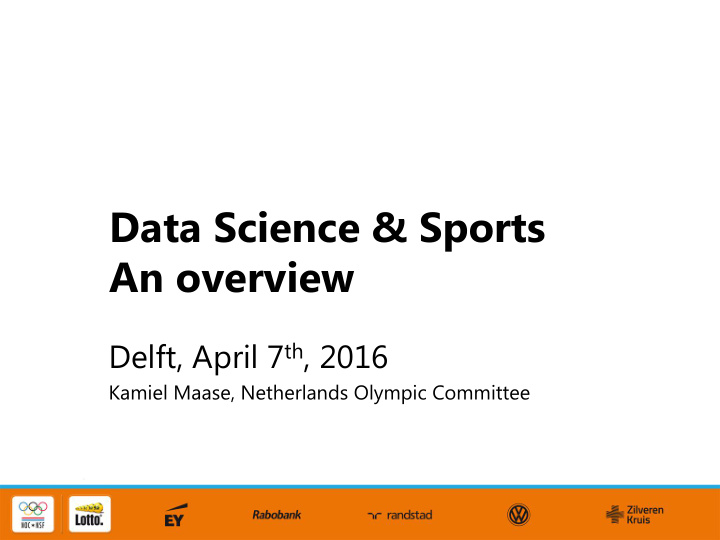



Data Science & Sports An overview Delft, April 7 th , 2016 Kamiel Maase, Netherlands Olympic Committee
Sport Science & Innovation Program MAIN GOAL: performance enhancement (medals!)
Support athletes, coaches, and their staff. By: 1. Distributing/ implementing knowledge Factsheets, protocols Seminars Sport science information center and helpdesk (Topsport Topics) 2. Hiring experts Sport dietitians transfer of expertise, dietary logs, anthropometry Embedded scientists daily support, measurements 3. Infrastructure Field labs, climate room testing, training Embedded scientists platform & network 4. Research and innovation Research Program Sport Sportinnovator Program, own projects often with companies Eat2Move (research and innovation on nutrition)
Picture: LinkedIn.com But, there is more DATA IN SPORTS, A POSSIBLE CLASSIFICATION
Types of data, a possible classification Recreational sports (‘organized’) : monitors : participation data, • club members, KISS (kengetallen sportparticipatie) ; Recreational sports (‘not organized’) : e.g. GPS data, social • data and city characteristics quantified self, large datasets ; Elite sports 1 : sports intelligence (competition results, • performance progression, performance outlook (‘funnels’), benchmarking tool for investment decisions; Elite sports 2 : deliberate measurements • Athlete measurements (physical, mental…) External/environmental measurements Competition analysis (technical, tactical) Involves technology like sensors, video … Zoom in …
Examples (elite sports 2) Regular measurements Heart rate, speed, contact times, position, power, personal logs; • Technical and tactical parameters (“tagging/ scouting”); • Anthropometry • Reasons to measure and record Steering of training • Direct feedback, learning • Match/race preparation and Match/race analysis prior to next round Protests
The era of (big) data science OPPORTUNITIES & CHALLENGES
Opportunities Larger data sets (elite sports: pooling of data, mass sports: Q-self) (Potentially) better analyses • Danger: haystack • Combine data From one-dimensional to multi-dimensional (multi-disciplinary) • Expected and unexpected correlations – data science • Computing power Power of the Crowd • Research programs Get the max of of your data: • Better performance Vital society Understanding the value of sports Picture: LinkedIn.com
Challenges Quantity and quality of data Most sports data sets are not ‘big’ • However: mixed nature (from research projects to regular • measurements) FAIR data: findable, accessible, interoperable, reusable • data formats , filing , and analysis Rules and regulations Privacy issues • Competitive edge (data of elite athletes) • Sports Data Valley • Learn from existing initiatives! This is just the beginning…
Recommend
More recommend